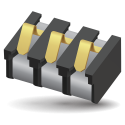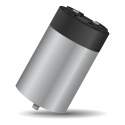Portable Electronics Require Smaller, More Modular SMT Battery Connectors Written By: Tom Anderson Abstract: Next-generation battery connectors face many new market demands, although the common ingredients remain the same: high life cycle, stability, simple design, and SMT compatibility.
News / Events / Press
Aluminum Electrolytic Capacitor Holder For Ruggedized Automotive Applications Written By: Tom Anderson Abstract: Harsh environments such as automotive and industrial applications can be very demanding on larger electronic components, which are exposed to severe shock and vibration requirements. In order to protect these components, extra attention and most often times cost needs to be devoted to the processing and mechanical attachment within the device to the Printed Circuit Board (PCB).
The Frequency Response Effects of Internal Component Configuration on Multiple Ceramic Dielectric System Written By: S. Pala | R. Demcko | M. Berolini Abstract: The purpose of this paper is to discuss the frequency response effects of internal designs within ceramic systems. Those effects will be related to component performance parameters for devices used to suppress ESD and control EMI in high speed data lines, which are prone to be damaged by ESD. As communication speed increase, systems become more complicated and performance standards tighten, options to improve EMI/RFI performance becomes of great importance. Long term EMI performance and reliability are of particular importance in automotive, medical and aviation application sectors. A performance comparison will be made between single element
SMT Process Characteristics of AVX TransGuards Written By: Ron Demcko Abstract: TransGuards are uniquely suited for wide-scale usage in SMT applications. TransGuards exhibit many advantages when used in SMT assemblies. This paper is a general guideline aimed at familiarizing users with the characteristics of soldering multilayer SMT ZnO TransGuards.
LCD Driver Circuit EMI Filtering Options Written By: Ron Demcko Abstract: A review of EMI filter component options, comparing product performance, device characteristics and related factors (eg PCB board area, placement cost, etc.).
Charge Control Methods for SuperCapacitors: Methods to Protect Power Sources from Damage Due to High Current Demands of SuperCapacitors Written By: Ron Demcko | Joe Hock | Ashley Stanziola | Daniel West Abstract: Circuit designs exploiting the increased energy storage provided by supercapacitors, requires careful consideration of the increased power handling, than that of batteries, when charging these devices. The unique composition of electrochemical double-layer capacitors (EDLC) inherently allows them to withstand large currents. Table 1 below is a brief list of AVX cylindrical (SCC) and series-connected module (SCM) SuperCapacitors, displaying peak current supply and sink current capability. These maximum specifications will typically exceed current capability of charge sources, and lead to failures within the power supply system. Supercapacitors have
Equivalent Circuit Model for Tantalum and Niobium Oxide Capacitors for use in Simulation Software Written By: J. Pelcak Abstract: In electrical circuit simulations with simulation software, ideal passive components (resistors, capacitors, inductors) are typically used because real component characteristics have been difficult to model. Unfortunately, ideal and real passive components have significant differences in their electrical behavior. These differences lead to discrepancies between actual hardware performance and expected results based upon simulation software programs. This paper will describe the development of equivalent circuit diagram for modeling real capacitor behavior. Use of this real model in simulation software can help make circuit development more efficient, as the circuits in the simulations should have similar behavior to the actual circuits. The model
How to Choose the Correct Accu-Guard Fuse for Circuit Protection Written By: Irina Daynov | Barry Breen Abstract: The ACCU-GUARD is designed to meet the need of electronic circuits for a small, accurate surface mount fuse. This article presents design guidelines for achieving optimal protection of circuits with ACCU-GUARD. All major parameters are described including operating temperature, circuit voltage, fault current, steady state current and current pulses (Joule integral).
Capacitor Selection and EMI Filtering Written By: Jeffrey Cain | Steve Makl Abstract: MLCCs are an inexpensive, yet effective, method for reducing the noise on both power/ground systems and signal lines themselves. Choosing the proper capacitance value such that the impedance is minimized at the frequency of interest also makes a difference.
Conductivity Mechanisms and Breakdown Characteristics of Niobium Oxide Capacitors Written By: J. Sikula | J. Hlavka | V. Sedlakova | L. Grmela | P. Hoeschl | T. Zednicek | Z. Sita Abstract: Niobium Oxide capacitor, has already found its place in the market as a cost effective and reliable non-burning component. The study of conductivity mechanisms has been done to prove its excellent stability, reliability and non-burning performance. Set of electrical measurements as VA characteristics in forward and reverse mode, frequency characteristics of capacitance, temperature or time dependence of basic parameters together with measurements of basic physical parameters enabled to propose the theoretical model of NbO – Nb2O5 – MnO2 system. NbO Capacitor shows identical conductivity mechanism as tantalum capacitor,
AVX Staticguard Performance Comparison to SOT-23 SMT Diodes Written By: Ron Demcko Abstract: AVX StaticGuard is designed to provide transient protection for MSI to VLSI CMOS circuitry. This article presents performance characteristics of low energy MLV transient voltage suppressors relative to low energy silicon diodes. All major parameters are described, including leakage current, clamping voltage, capacitance, peak current and repetitive strike performance. AVX StaticGuard is shown to have superior performance to SOT 23 diodes in transient suppression applications.
Basic Guidelines of Conductive Polymer Capacitors Written By: S. Zedníček | J.Petržílek | P.Vanšura | M.Weaver | C.Reynolds Abstract: Conductive Polymer Capacitors are relatively new solid electrolytic capacitor technology on the market. The range of application is growing also due to their low ESR and safe operational characteristics. The paper addresses frequently asked questions about construction, parametric performance, product life, product specifications, recommendations and applications.
Using High-Directivity Couplers in Isolatorless Cellular Phone PA Control Written By: Avital Yaish Abstract: This article outlines the use of High-Directivity Couplers in Cellular handsets. Benefits can include increased talk-time, minimized insertion loss between the PA and the antenna and can also remove the need for an isolator. A version of this article was previously published in RF Design, April 2006.
AVX EMI Solutions Written By: Ron Demcko | Chris Mello | Brian Ward Abstract: EMC compatibility is becoming a key design parameter for a most designers of electronic systems. This paper compares the efficiency and effectiveness of various EMI filter options available to designers. Integrated Thick Film LC T filters are shown to be a cost effective method to improve board level EMC performance while shrinking system design size and keeping costs minimized. A general recap of EMI sources is given as well as a brief recap of PCB layout and optimization rules.
Thin-Film Passives in RF/Microwave Circuits Written By: Ron Demcko Abstract: Until recently, most microwave capacitors were based on fired multilayer ceramic technology. In this process, layers of highly conductive electrode metal alloys are interleaved with low-loss ceramic dielectrics in a multilayer fashion until the target capacitance is obtained. The resulting stack is then sintered into a monolithic structure in a high-temperature firing process. This process continues to satisfactorily serve highpower capacitor needs in addition to those in larger value RF capacitors…
Evolution of Power Capacitors for Electric Vehicles Written By: Gilles Terzulli Abstract: Electric vehicles are in widespread use. Hybrid cars are now a common sight on our roads as people look to find more environmentally-friendly forms of personal transport, and there are many other commercial and public electric vehicles, such as trains, trams, buses and industrial trucks and equipment in everyday use. The electronic systems and components that have enabled the realisation of such a wide variety of electric vehicles have all experienced a major evolution, including the DC link power capacitor. The purpose of capacitors in electric vehicles is to prevent ripple currents from reaching back to the power source, and to smooth out DC bus voltage variations. Capacitors








